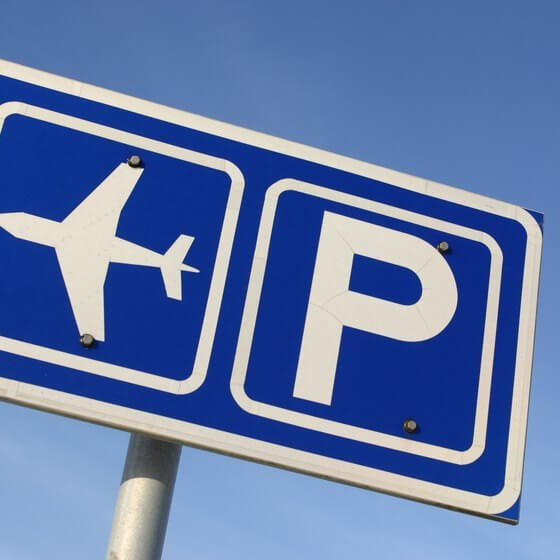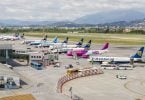Recognizing how frustrating parking can be for travelers (and also recognizing that parking is an important source of revenue), airports across the United States are introducing cutting-edge parking technologies to make their parking facilities more customer-friendly and safer, while at the same time making them more competitive relative to independent satellite lots. These technologies are designed to get travelers into open parking spaces and into terminals as quickly as possible. Other technologies are designed to get weary returning flyers into their vehicles and on their way home as conveniently as possible.
Airports are adding a number of cutting-edge parking technologies, including:
Parking Guidance Systems: Parking guidance systems use illuminated sensors to record whether a space is open or occupied and relays that information to parkers with a series of highly visible colored lights (green means available; red means occupied; blue means HP). Guidance systems also typically employ LED Matrix signs at the entrances of garages and on each floor indicating how many spaces are available. Parking guidance systems can reduce the time it takes to find parking by as much as ½ hour in some garages. Many well-known airports, both large and small, have installed parking guidance systems in recent years.
Frictionless parking: Frictionless parking is the latest technology strategy to be introduced to the airport industry. Frictionless parking combines a number of parking technologies that can include license plate recognition (LPR) technology and software, bar code readers, RFID technology, mag strip readers, and Bluetooth technology to allow travelers to enter and exit parking garages without stopping to pull a ticket upon entry or queuing to pay when leaving. The system recognizes the vehicle when it enters the facility and automatically charges the driver. Frictionless parking systems can be extremely beneficial to travelers who are in a rush to make a plane or who are returning and are in a rush to get home. Last year, San Diego International Airport introduced the world’s most advanced frictionless technology suite, which also integrates parking guidance and parking reservations technology.
Parking Reservations: Advance parking reservations are common at European and Canadian airports, but are just now gaining traction in the U.S. Through these systems, travelers go online before driving to the airport and reserve a parking space in the parking facility that is closest to their terminal. They pay for a specific space and upon entering the garage are directed to that space. Reservation systems provide incredible convenience for travelers, and they also generate vital utilization data that airports can use to better manage their parking assets and provide an even better parking experience for travelers.
Parking impacts our lives every day. Parking, or sometimes lack thereof, influences where we choose to shop, work, and live. It can also have a dramatic impact on property values, the quality of life of residents, and the success of local businesses. And today, parking technology plays a more important role than ever before, with new tools and technology suites constantly being introduced to make parking more convenient for drivers and more manageable for buildings owners and operators. These same technologies will be the key to creating connected smart cities.
According to Bill Smith of Smith Phillips Strategic Communications, the advent of the connected smart city age will transform cities, making it easier than ever to travel to and from cities, and parks once we get there. What will the mobility age look like and how will it impact our lives? What role will parking play? How is parking technology permitting the creation of the connected smart city and what are the most important technologies?
Municipal parking planning. Effective municipal parking planning can promote a community’s economic growth, while bad planning—or a lack of planning—can turn a community’s business districts and residential neighborhoods into modern-day ghost towns. What are the key elements to any successful municipal parking plan? What are the most common mistakes that are made by parking planners? How can cities know how much to charge for parking and how best to manage their parking assets? How does effective parking planning impact the nature of a community’s downtown or other neighborhoods? What can city planners do to assure future planning success?
Parking’s technological revolution. Technological innovation is transforming parking. New parking technologies like frictionless parking and parking guidance are improving the way cities and other parking owners manage their parking resources. How is technology changing parking planning and management? What are the most important technological tools and trends? How are mobile applications making parking more convenient for drivers and more manageable for cities and other parking owners? What’s around the corner when it comes to parking technology?
Self-driving vehicles and the future of parking. One of the most intriguing technologies currently under development is self-driving or autonomous vehicles. While everyone agrees that it will have an enormous impact on our cities and towns, no one seems able to agree on how big that impact will actually be. How will SDVs impact parking and transportation planning? How much will SDVs reduce parking demand, and what does that mean for municipal planners and building owners? What do municipal planners, developers, and building and complex owners need to do to prepare for the SDV age? How can parking owners create flexibility into their parking facilities in preparation for reduced parking demand?
Financial implications of parking. Communities often balk at investing in new parking or upgrading existing parking resources because of the expense. How can communities invest in new or upgraded parking while minimizing their costs? What financing strategies are available to communities to pay for parking? What are the most common financing challenges facing cities and towns and how can they be overcome? How can cities and towns utilize parking technology to improve parking services, promote economic development for downtown businesses, and generate additional revenues?
New dawn of airport parking. Parking is an essential resource for any airport. In fact, many airports earn more money from parking than from gate fees. What are the basic elements of airport parking design and planning? How is technology revolutionizing airport parking? What is frictionless parking and why are airports turning to it to provide travelers a better parking experience? What is parking guidance (PGS) and how are airports using it to improve the travel experience, while generating more parking revenue? What is pre-booking and why are airports turning to parking reservations platforms to be more competitive? Which airports are leading the way in using technology to improve the travel experience and operate their parking facilities more effectively?
Campus parking in the 21st Century. Parking planning isn’t just a challenge for cities and towns. Institutions, particularly those with campuses like universities and hospitals, also face numerous parking planning challenges and opportunities. What are the most common parking challenges facing universities, healthcare complexes, and office parks, and how can they be overcome? What are the latest parking planning trends for campuses? How campuses utilizing frictionless parking, parking guidance, and other technologies to improve the parking experience on campus and generate new revenues? Which universities are leading the way in applying parking technology?
Frictionless parking. Frictionless parking is one of the hottest trends in parking today. Frictionless parking permits drivers to park without interacting with traditional payment systems, and it revolves around a suite of technologies built on top of a Parking Access Control System, such as license plate recognition (LPR), barcode readers, and reservation software, that make parking seamless and interactive by removing the need to stop at gates to enter or stop at exits to pay. Parkers just drive in and out as they wish, and the system recognizes the vehicle, associates it with a previously generated credential, and bills the driver or credits it to a permit, often through a smartphone.
Parking guidance. PGS utilizes sensors to monitor whether a parking space is occupied or free, and the status of each space is indicated through a series of highly visible lights. If the light is green the space is available, if it’s red it’s occupied. Other lights can be used to indicate HP, short-term, or other types of parking. Guidance systems feature signage at major decision points, such as facility entrances and on each floor, indicating how many spaces are available. PGS is also a useful management tool that provides valuable data about how parkers are using parking resources and during which hour of the day. This data can be used to make better management and operations decisions to improve the parking experience and maximize parking revenues.
Parking reservations platforms. Parking reservations technology allows drivers to reserve a parking space close to their destination before they even leave the house. Using a desktop or handheld device, the traveler merely logs onto the system, selects a parking space, and pays for that space. He or she then drives to the parking facility, proceeding to the reserved space. Some systems even include signage above spaces that display the name of the person who reserved it. Parking pre-booking is particularly popular at airports, and is now making its way into retail complexes, universities, and other parking facilities.
Open-source software. The next frontier of parking technology will be opensource software to manage parking technologies and systems. Traditionally, when parking owners have purchased parking equipment, they have been at the mercy of the software that comes with it. Often, they find that while their equipment suppliers make great hardware, they aren’t as proficient at creating useful software. With open source technology, equipment providers allow third-party software providers and developers to offer software that will make their data work better as an integral part of their overall operations IT design and operations management. It’s the future of parking software, and it’s right around the corner.























